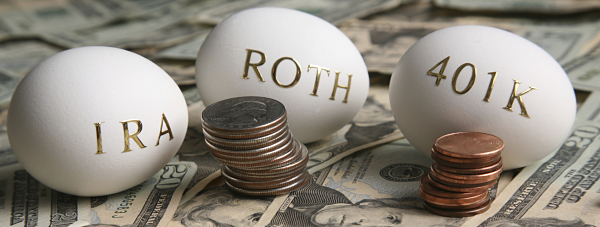

Roth IRA, Roth 401(k), Roth Solo 401(k) — What’s the Difference?

Traditional 401(k) and IRA retirement accounts offer the benefits of tax deferral: You contribute before-tax money that can grow uninterrupted, and you pay taxes only at the time of withdrawal.
With a Roth account — Roth IRA, Roth 401(k) or Roth Solo 401(k) — the tax treatment is essentially the opposite. You make contributions with after-tax dollars, but your withdrawals (of both contributions and investment earnings) are tax-free.
Related: Advantages of a Self-Directed Solo 401k
Because investment gains in Roth accounts are tax-free, it can make sense to use one to hold assets that have the potential for significant increases in value. Younger investors can also benefit from Roth accounts because they have more time for their investments to grow in this tax-free environment.
That said, there are some key differences among the various types of Roth accounts that retirement savers should understand:
Roth IRA
The Roth IRA is probably the most popular type of Roth retirement plan. While a 401(k) must be set up by an employer, an IRA can be set up individually. You can shop around for the plan provider with the best investment options and the lowest costs and fees.
You can open a Roth IRA even if you contribute to a 401(k) through your employer, provided your income is below a certain level. The maximum contribution anyone can make is $5,500 as of 2015, with an additional “catch-up” contribution of $1,000 for those age 50 or older. Under the Roth IRA contribution limits, the maximum begins to phase out for single taxpayers making more than $116,000, and singles making more than $131,000 can’t contribute at all. For married couples filing jointly, the reduction in the maximum contribution begins at $183,000 of income, and those making more than $193,000 can’t contribute at all. These limits are subject to change with inflation.
Roth 401(k)
Many employer-sponsored 401(k) plans offer a Roth option. Employees can contribute up to $18,000 in 2015, a much higher limit than for Roth IRAs. There are no income limits on Roth 401(k) contributions, and employees can also take advantage of any matching contributions their employer provides.
However, employees ultimately do not get to decide whether they have a Roth 401(k). It is up to the employer to add the option to the company’s 401(k) plan. Investment options are also limited to what’s offered by the plan provider chosen by the employer.
Roth Solo 401(k)
Solo 401(k) and Roth Solo 401(k) accounts are available only to self-employed individuals. Plan participants can work full-time for another employer, but to qualify for a traditional or Roth Solo 401(k), they must show proof of self-employed business activity. Since Solo 401(k), or “Solo K,” plans are designed for individuals only, business owners can use one only if they don’t have any full-time employees.
There is no income limit for Roth Solo 401(k)s, although contributions are limited to $18,000 per year as of 2015. (Those age 50 and older can make an additional $6,000 a year in catch-up contributions.) Since Solo 401(k)s are individual accounts, they can be self-directed, and the investment options are virtually unlimited.
One of the key benefits that Solo 401(k) plans offer — and that a Roth Solo 401(k) does not — is the ability to make profit-sharing contributions in addition to your normal salary-deferral contributions. Since these plans are designed for those who are self-employed, you wear two hats: employee and employer. As the employer, you’re able to put up to 25% of the net earnings of the business into the Solo 401(k). The maximum total contribution — salary deferral plus profit sharing — is $53,000 a year as of 2015. Catch-up contributions for those 50 and older push that maximum to $59,000.
Again, you can’t make profit-sharing contributions to a Roth Solo 401(k) — but these contributions can later be converted into a Roth account, so plan owners can still give their Roth accounts a big boost and invest more of their retirement funds tax-free.
To Roth or not…
Many people choose Roth accounts because they expect tax rates to be higher during their retirement years; they opt to pay taxes now at what they believe will be lower rates. Others may choose to have both a traditional 401(k) or IRA and a Roth account so that they can diversify their tax liabilities during retirement.
Whatever you do, make sure you understand these important differences — and how you can make the most of your retirement savings.
This article was originally published on NerdWallet.com




Comments (4)
Great stuff Dmitriy. Thank you. I'm new to the idea of intentional real estate investing. If investing with Roth IRA money that is leveraged how does the IRS treat gains before and after the loan is paid? Can you both reduce taxable income on the gains from the leveraged portion of the investment with depreciation and be protected from those cap gains taxes when the property is sold if that loan had been paid off?
Adam Nagao, over 7 years ago
Adam, if the property is leveraged in an IRA - the income would be subject to UBIT. If Roth 401k owns the property it would be exempt from UBIT on leveraged real estate. There are no capital gains tax because the property is inside tax sheltered vehicle. Qualified distributions from Roth are tax free.
Dmitriy Fomichenko, over 7 years ago
I've always wondered what a Roth was. Thanks for writing this blog. You clarified a lot for me. I'm going to find out if my job has a Roth option on my 401k. If not than I'll have to set up a Roth IRA.
David White, over 9 years ago
David, I'm glad it was helpful to you. The sooner you start investing out of Roth, the more beneficial it will be for you (more time to grow your wealth tax-free!).
Dmitriy Fomichenko, over 9 years ago